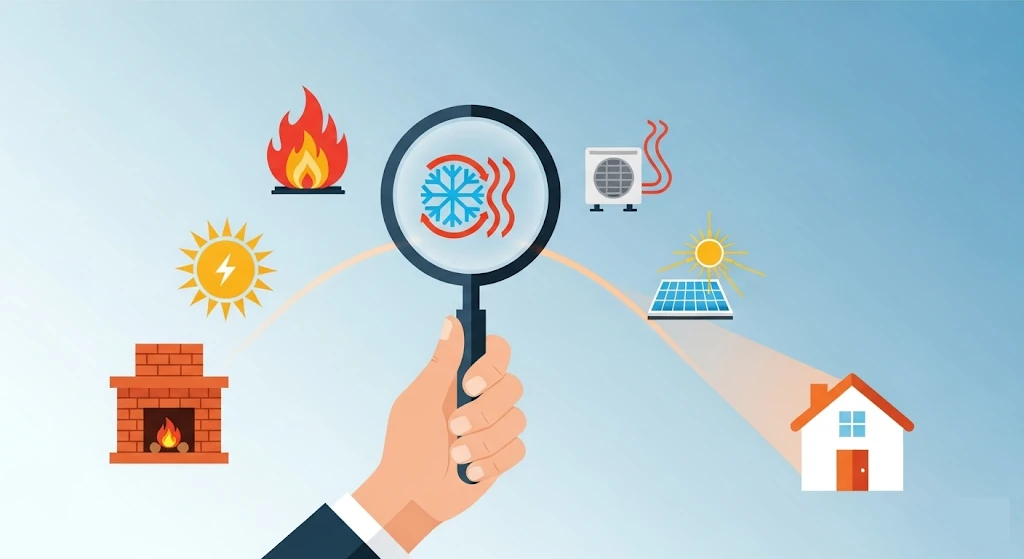
When it comes to keeping your home warm and cozy, selecting the right heating source is essential for both comfort and efficiency. With so many options available, it can be overwhelming to figure out which one is best for your needs. From traditional furnaces to modern heat pumps, each heating system comes with its own set of benefits and drawbacks.
To help you make an informed decision, we’ve compiled six key tips to guide you through the process. Whether you’re looking to reduce energy costs, increase your home’s sustainability, or simply stay warm throughout the winter, these considerations will ensure you choose the ideal heating source to suit your lifestyle and budget. Let’s dive in.
Understand Your Heating Needs and Home Layout
Before diving into the different types of heating systems available, it’s crucial to assess your specific needs. Do you live in a small apartment or a large house? Are you located in a region with extreme temperatures or moderate seasonal shifts?
Understanding your home’s layout and climate will help determine which heating source is most efficient and cost-effective. As highlighted by the team at Cinergi, there are different types of heat sources for different needs, including air source heat pumps, solar, and geothermal systems, each designed to provide the best results based on the heating demands of your home. By considering factors like room size, insulation, and local climate, you can choose the system that will work most effectively for your space.
Evaluate Energy Efficiency and Costs
Energy efficiency is one of the most important factors to consider when choosing a heating source. Not only does it affect your environmental impact, but it also directly influences your energy bills. Systems such as heat pumps and modern furnaces are designed to use less energy while still providing effective warmth.
Before making a decision, take the time to research the seasonal energy efficiency ratio (SEER) or annual fuel utilization efficiency (AFUE) ratings of various heating systems. While some systems may have a higher initial installation cost, their long-term energy savings could make them a more economical choice. Additionally, consider government rebates or incentives for energy-efficient systems to help offset the costs.
Consider Maintenance Requirements
Some heating systems require more frequent maintenance than others. Regular maintenance ensures that your system continues to function properly and efficiently throughout its lifespan. Systems like gas furnaces and electric baseboard heaters often need routine cleaning and inspections, while heat pumps and boilers may require professional servicing at least once a year.
When choosing a heating source, it’s important to consider the time and cost involved in maintenance. Opting for a system with minimal upkeep requirements could save you time and money in the long run, allowing you to enjoy reliable comfort with less hassle.
Factor in Installation and Upfront Costs
The upfront cost of purchasing and installing a heating system can vary significantly depending on the type and complexity of the system. While traditional forced air systems might be relatively inexpensive, systems like geothermal heat pumps and hydronic heating can involve higher installation costs due to the need for specialized equipment and labor.
Keep in mind that while the initial investment might be higher for some options, you could recoup the costs through long-term energy savings. Therefore, it’s important to strike a balance between your budget and the anticipated long-term benefits of the heating source you choose.
Think About Long-Term Sustainability
As energy concerns and environmental awareness grow, sustainability has become a key factor in choosing a heating system. Opting for eco-friendly options such as solar heating, geothermal, or air-source heat pumps can significantly reduce your home’s carbon footprint. These systems use renewable energy sources, which makes them a great option for reducing reliance on fossil fuels.
Furthermore, they often qualify for green energy incentives or rebates, making them more affordable over time. By investing in a sustainable heating source, you’ll not only lower your environmental impact but also ensure that your system remains relevant in the future as energy efficiency standards become more stringent.
Assess the Comfort Level and Consistency of Heat Distribution
Different heating sources distribute heat in various ways, and the method of distribution can have a significant impact on your comfort. Forced air systems, for example, quickly heat the air and circulate it throughout your home via ductwork. However, they can also cause uneven temperatures, with some rooms being warmer than others.
On the other hand, radiant floor heating offers more consistent warmth, heating objects and surfaces directly rather than the air. Additionally, systems like hydronic heating can be particularly comfortable in colder climates due to the way they gently heat rooms. It’s essential to think about how a heating system’s distribution method will impact the overall comfort and feel of your home.
Choosing the right heating source for your home involves considering factors like energy efficiency, installation costs, maintenance needs, and environmental impact. By assessing your specific heating needs, home layout, and long-term goals, you can make an informed decision that provides both comfort and savings. Whether you opt for a traditional furnace or a modern, eco-friendly system like a heat pump or solar heating, each option offers unique benefits tailored to different requirements. Ultimately, selecting the right heating source ensures your home remains warm, comfortable, and energy-efficient for years to come.


